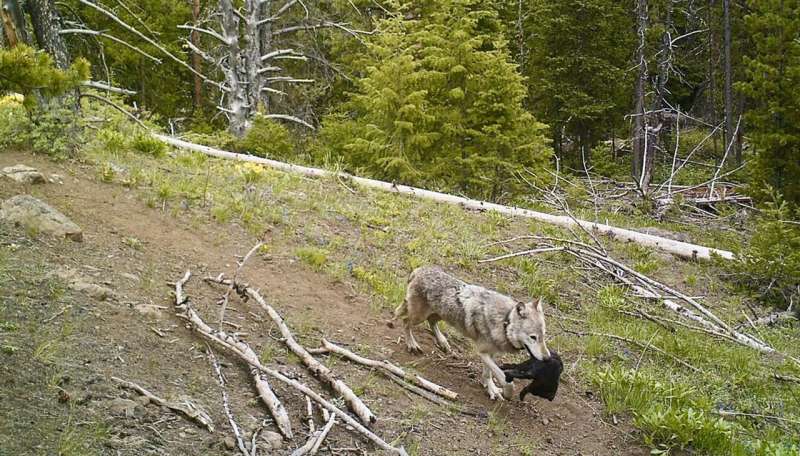Science
Gray Wolves Adapt Tactics to Follow Elk Migration in Yellowstone

Gray wolves near Yellowstone National Park have been observed taking significant risks to follow migrating elk, even carrying their young pups over challenging terrain. This unexpected behavior was documented by researchers from the University of California – Berkeley, revealing that these wolves can travel distances of 20 kilometers or more during the elk’s spring migration season.
The study, published on August 1, 2025, in the journal Current Biology, highlights the adaptability of gray wolves in response to their prey. Avery Shawler, the first author of the study, expressed surprise at the sight of a wolf carrying its pup, humorously noting the awkwardness of the scene: “You can picture a squirming child and the mom just being like, ‘All right, we’re doing this.'”
Wolves typically remain tied to their dens while rearing young pups, which are born blind and deaf, relying on their mothers for survival. Researchers believe these journeys are motivated by the need to position their packs closer to elk, which are their primary food source. This behavior marks a significant shift in understanding wolf migration patterns, as it is the first documented instance of gray wolves outside the Arctic migrating to follow prey during the pup-rearing season.
According to senior author Arthur Middleton, a professor of environmental science, policy, and management at UC Berkeley, the findings challenge longstanding assumptions that migratory animals can evade predation in spring due to predators being confined to their dens. Understanding the dynamics between wolves and elk is crucial for conservation efforts, especially as both species face increasing pressures from climate change and land-use shifts.
In the Greater Yellowstone Ecosystem, where the gray wolf population is estimated to be around 500 since their reintroduction in **1995**, the researchers tracked the movements of 19 wolves and 99 elk between 2019 and 2021 using GPS collars. The results indicated that while some elk herds migrate only short distances, others travel significantly farther, prompting wolves to adapt their behaviors accordingly.
The study identified two primary strategies: “commuting,” which involves temporary excursions outside established territories to follow migrating herds, and “migrating,” where wolves shift to completely new seasonal ranges following elk up to 50 kilometers. Remarkably, some wolves carried pups across distances of 20 kilometers to reach rendezvous sites.
Shawler noted the risks involved in this behavior, particularly in a competitive environment where wolf mortality can occur from rival packs. “It’s pretty wild that this risky behavior of moving young pups is even occurring when that’s happening next door,” he stated.
These insights into gray wolf behavior have implications for conservation strategies in regions where they coexist with human activities. Shawler highlighted the importance of understanding how wolves adapt to working landscapes, particularly in California, where the population has grown to approximately ten packs since recolonization began in **2011**.
Middleton, who co-leads the California Wolf Project, emphasized that research in Yellowstone enhances their understanding of wolf behavior in California. “While it’s still early days, our partners in California have a strong hunch that the numbers and movements of deer and elk are playing into wolf behavior, including livestock predation,” he explained.
This research not only sheds light on the complex interactions between wolves and their prey but also provides valuable information for land management strategies aimed at reducing human-wildlife conflict in areas where these predators roam. The findings underline the adaptability of gray wolves in a changing environment, offering a glimpse into the future of wildlife management as ecosystems evolve.
The collaborative effort of researchers, including Kristin J. Barker, Wenjing Xu, and Kenneth J. Mills, contributes to a growing body of knowledge that will inform conservation efforts for gray wolves and their habitats in North America.
-

 Entertainment2 weeks ago
Entertainment2 weeks agoLove Island Star Toni Laite’s Mother Expresses Disappointment Over Coupling Decision
-

 Entertainment2 weeks ago
Entertainment2 weeks agoWoman Transforms Life with Boot Camp, Losing Nearly 9 Pounds in a Week
-

 Lifestyle3 weeks ago
Lifestyle3 weeks agoBring Birds to Events and Dine with Style: Trends This Week
-

 World3 weeks ago
World3 weeks agoCoronation Street Recasts Lily Platt Amid Dramatic Storyline
-

 Entertainment1 week ago
Entertainment1 week agoMary Goskirk’s Injury Raises Questions in Emmerdale Episode
-

 Sports3 weeks ago
Sports3 weeks agoGAA Faces Controversial Decision on DJ Carey Before Final
-

 Entertainment3 weeks ago
Entertainment3 weeks agoBob Vylan Drops Out of European Tour with Gogol Bordello After Controversy
-

 Lifestyle3 weeks ago
Lifestyle3 weeks agoAylesbury Committee Approves Controversial 24-Hour McDonald’s
-

 Entertainment3 weeks ago
Entertainment3 weeks agoJessica Alba’s New Relationship Unveiled with Younger Actor
-

 Entertainment3 weeks ago
Entertainment3 weeks agoKeeley Hawes Takes Risks in High-Octane New Series The Assassin
-

 World3 weeks ago
World3 weeks agoBritish Man, 26, in Critical Condition After 22ft Fall in Ibiza
-

 Top Stories2 weeks ago
Top Stories2 weeks agoNicki Minaj and SZA Engage in Heated Social Media Feud









